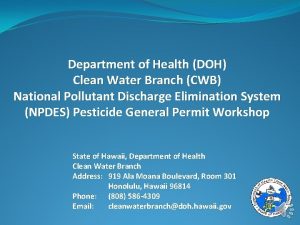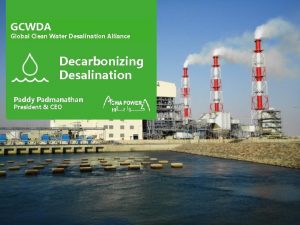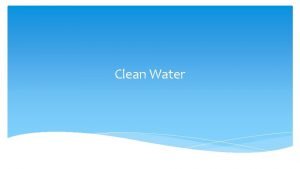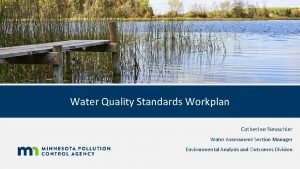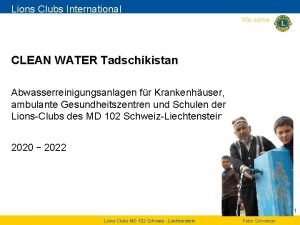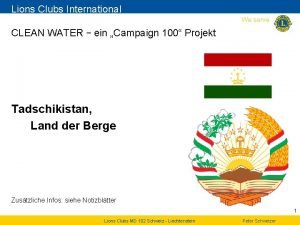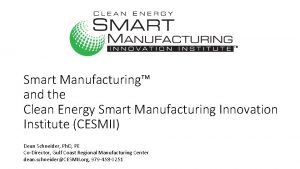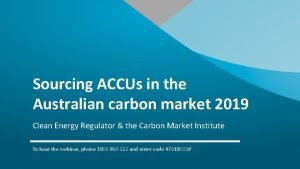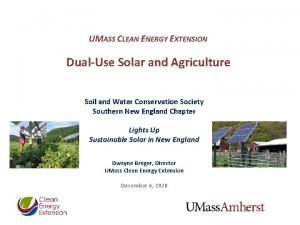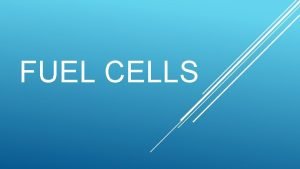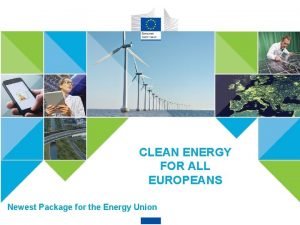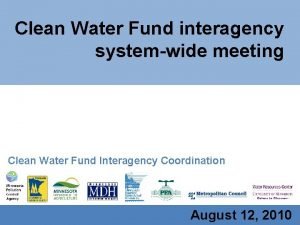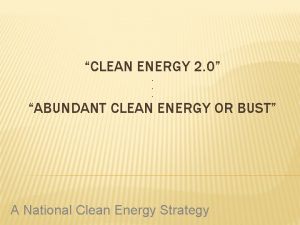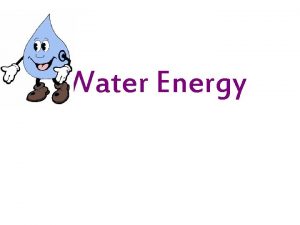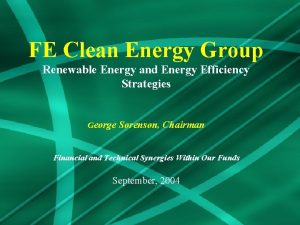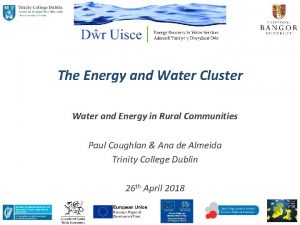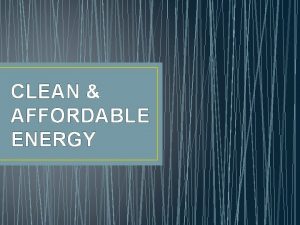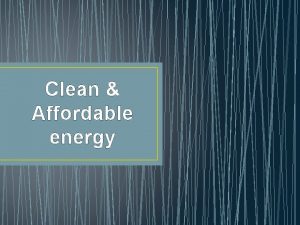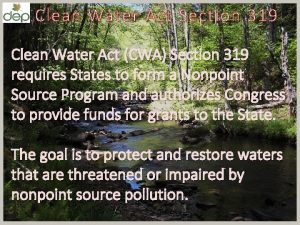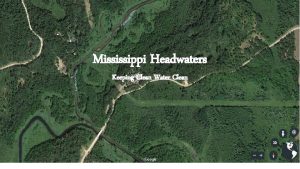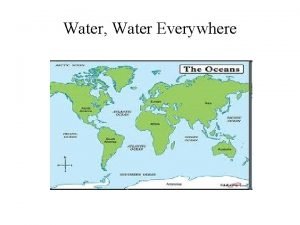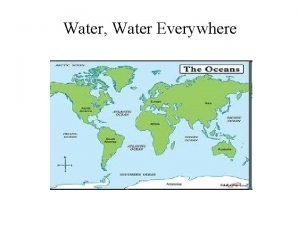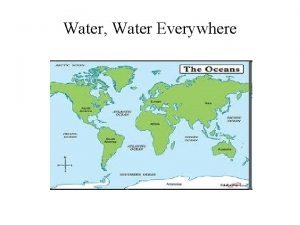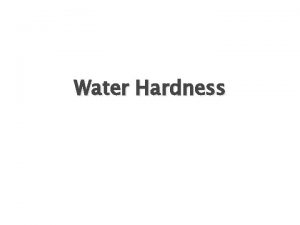Center for Clean Water And Clean Energy at


























- Slides: 26

Center for Clean Water And Clean Energy at MIT & KFUPM Department of Mechanical Engineering Design Protocols and Risk Management in Complex Projects with Applications to Water Desalination, Clean Water and Clean Energy Systems MIT (PI) Prof. Warren Seering KFUPM (PI) Prof. Abdel-Salam M. Eleiche (ME) Prof. David Wallace Prof. Anwar Khalil Sheikh (ME) Prof. Maria Yang Prof. Iyad Talal Alzaharnah (ME) 2010 KFUPM, January 2010 Massachusetts Institute of Technology Dr. Victor Tang Prof. Abdulaziz Bazoune (ME) Dr. Josef Oehmen Prof. Mohammed Prof. Muhammad Fahad Ben Daya Al-Salamah (SE) Massachusetts Institute of Technology

Center for Clean Water And Clean Energy at MIT & KFUPM Background and Motivation Department of Mechanical Engineering Background • Engineering design transforms customer needs into physical products or systems • If product or system requires more than a few people to develop, structured processes should be used to orchestrate work • Large body of research on processes, but in practice, projects laden with inefficiencies • Key decisions made during early phase of system development – Mistakes very costly – Ricoh: $35 problem in early phase = $17, 000 in mfg = $690, 000 at customer (Hamada 96) • Few risk management methods for early phase of product development Motivation • Provide framework for utilizing existing and new knowledge bases and methods of design and risk reduction in the domain of clean water and clean energy KFUPM, January 2010 Massachusetts Institute of Technology

Center for Clean Water And Clean Energy at MIT & KFUPM Department of Mechanical Engineering Project initiatives Research areas Risk Management Design Requirements Technology Readiness Educational Impact – Risk Mgmt Laboratory Outreach Integration with Saudi Industry Partners KFUPM, January 2010 Massachusetts Institute of Technology Links to other KFUPM-MIT Projects

Center for Clean Water And Clean Energy at MIT & KFUPM Activities to date • • Department of Mechanical Engineering Identification of project initiatives Development of a project Wiki (CMS) on the Internet Five videoconferences from October to December 2009 Visit by Dr. Josef Oehmen of MIT to KFUPM on 7 -18 December 2009 – Seminars by Dr. Oehmen to ME and SE Depts • Round-table discussions with three SA Industry partners on 10 January 2010 KFUPM, January 2010 Massachusetts Institute of Technology

Center for Clean Water And Clean Energy at MIT & KFUPM Department of Mechanical Engineering KFUPM, January 2010 Massachusetts Institute of Technology

Center for Clean Water And Clean Energy at MIT & KFUPM Department of Mechanical Engineering Risk Management in Product Design and Development (PDD) KFUPM, January 2010 Massachusetts Institute of Technology

Center for Clean Water And Clean Energy at MIT & KFUPM Risk Management in Product Design and Development Department of Mechanical Engineering • Goal – Understanding overall risk in the value chain through factors that can be addressed in PDD • Project areas – Considering balancing risks in a portfolio of product development projects – Improving risk management in PD to reduce risk in down stream processes Early stage design Production ramp up Risk KFUPM, January 2010 Massachusetts Institute of Technology Collaboration with suppliers Sales and marketing Product distribution

Center for Clean Water And Clean Energy at MIT & KFUPM Current work: Literature review Department of Mechanical Engineering • Focus in the areas of – Risk management in single product design projects – Risk management of product design project portfolios – Integrated risk management across different engineering domains (e. g. PD, production, and service) • ~ 50 papers and books reviewed so far KFUPM, January 2010 Massachusetts Institute of Technology

Center for Clean Water And Clean Energy at MIT & KFUPM Summary of Conclusions and Research Gap Department of Mechanical Engineering • Findings from literature – No design process framework and corresponding methods for risk management in PD – No comprehensive methods for different phases of risk management process – New ISO 31000 important in developing risk management reference processes • Observations for research – Product development managers have to manage portfolios of PD projects, but no structured approaches – The integration of risk management and product development practices remains an important and not sufficiently investigated field of research KFUPM, January 2010 Massachusetts Institute of Technology

Center for Clean Water And Clean Energy at MIT & KFUPM Department of Mechanical Engineering Design requirements KFUPM, January 2010 Massachusetts Institute of Technology

Center for Clean Water And Clean Energy at MIT & KFUPM Design Requirements • Design requirements balance vision of stakeholders (users, development team, regulators…). – Shared understanding of product goals • Examples – “The plant must operate under wind speeds of X kmh” – “The laptop must operate after a drop of Y meters” • Good design requirements difficult to create – Integration of customer/market needs with engineering considerations – Limited methodologies • Research areas – Process of formulating design requirements – Categories of risks in requirements – Changes in requirements over time KFUPM, January 2010 Massachusetts Institute of Technology Department of Mechanical Engineering

Center for Clean Water And Clean Energy at MIT & KFUPM Strategies for generating design requirements Department of Mechanical Engineering • Elements of design requirements – – Customer and user needs, market data Engineering characteristics Informal strategies (interviews, surveys) or structured (QFD) Different practices at different companies • Research goals: – Literature review and observations of design requirements in industry/case studies – Categorization of strategies for design requirement generation – Metrics for design requirement “completeness” – Controlled studies of design teams generating design requirements KFUPM, January 2010 Massachusetts Institute of Technology

Center for Clean Water And Clean Energy at MIT & KFUPM Understanding risk in design requirements Department of Mechanical Engineering • Ways to specify risks in design requirements? – Risks inherent in any design requirement • Risk of defining a requirement incorrectly • Risk of omitting a design requirement • Risk of not meeting the requirement • Interactions among risks • Others… – Which are important to evaluate? • Research goals: – Define categories of risk in design requirement specification – Evaluate design requirements and risks generated in industrial settings – Controlled studies of design teams generating design requirements KFUPM, January 2010 Massachusetts Institute of Technology

Center for Clean Water And Clean Energy at MIT & KFUPM Department of Mechanical Engineering Flexibility in specifying design requirements • Design requirements often change over time – New information during development 100% • Ideal: design team maintains shared understanding during changes • What does “flexibility” in design requirements look like? Design freedom Knowledge about the design – Set-based design (Ward, et al 90) • Research goals – Track how design requirements change over time • Industry settings • Laboratory environment – Metrics for “flexibility” in design requirements KFUPM, January 2010 Massachusetts Institute of Technology Time

Center for Clean Water And Clean Energy at MIT & KFUPM Department of Mechanical Engineering Technology readiness levels KFUPM, January 2010 Massachusetts Institute of Technology

Center for Clean Water And Clean Energy at MIT & KFUPM Department of Mechanical Engineering What is it? Origin? Generic uses? • The Original Model/Use Description. • Other Models/Applications. NASA’s TRL Scale • Technology Readiness Levels: • Our objectives? www. wikipedia. com KFUPM, January 2010 Massachusetts Institute of Technology

Center for Clean Water And Clean Energy at MIT & KFUPM The TRL: Origin/Primary Purpose/Uses Department of Mechanical Engineering Definition q They are a scale that describes the maturity of a technology with respect to a particular use- Scale from 1 (least mature) to 9 (most mature). Origin q NASA developed (in early 1990 s) a new standard: the q To help engineers, technology development managers, and Technology Readiness Level or TRL to assess the maturity of researchers make decisions concerning the development and evolving technologies (especially related to the sustainable transition of technology. : energy technologies). Primary Purpose KFUPM, January 2010 Massachusetts Institute of Technology

Center for Clean Water And Clean Energy at MIT & KFUPM Original Model/Use Description NASA’s Description: TRLs represent a systematic metric/measurement system that supports assessments of the maturity of a particular technology and the consistent comparison of maturity between different types of technology. Department of Mechanical Engineering A Classical Model for a Technology Product; the Development Generally Includes Following Successive Stages ‘basic’ research The Traditional NASA TRL Levels TRL 1 Basic principles observed and reported Focused Technology Development & Demonstration TRL 9 Actual system “flight proven” through successful mission operations KFUPM, January 2010 Reference: John C. Mankins. Institute (Advanced Concepts Office Massachusetts of Technology of Space Access and Technology NASA) System Development

Center for Clean Water And Clean Energy at MIT & KFUPM Other Articulated Models Department of Mechanical Engineering The U. S. Department of Defense (DOD) Model The U. S. Department of Energy (DOE) Model q Technology Readiness Assessment (TRA) model, which consists of three sequential steps: - Identifying the Critical Technology Elements (CTEs). - Assessing the Technology Readiness Level (TRL). [as an intermediate stage in the technology development process] - Developing a Technology Maturation Plan (TMP). KFUPM, January 2010 Massachusetts Institute of Technology TRL (N) Viability Verification Requirement s NO Description The European Space Agency Model “Generic Technology Readiness Assessment Steps” TRL (N-1) YES

The Technology Readiness Level Initiative Center for Clean Water And Clean Energy at MIT & KFUPM Department of Mechanical Engineering Objectives: : • Developing an understanding through implementing on ongoing selected projects (A preliminary questionnaire has been developed-It has been implemented on some of the ongoing projects from MIT side). • Developing strategic next steps that might be taken to advance the technology’s readiness, and/or mitigate technology readiness risks. • The recommendation for advancing technology readiness can be further enhanced by incorporating proven methods for product requirement specification and risk management in product development. Published Applications in Technical (technology) Research • FUSION ENERGY • Plasma and Power Flow in a Reactor • NEXT Ion Propulsion System, KFUPM, January 2010 Massachusetts Institute of Technology Le. Gresley et al 2000

Center for Clean Water And Clean Energy at MIT & KFUPM Collaboration with other KFUPM researchers Department of Mechanical Engineering • Preliminary evaluation of metric with two KFUPM-MIT faculty on their projects – Initial TRL metric adapted from NASA – Prof. Evelyn Wang – Prof. Rohit Karnik • Initial findings – Different aspects of the same technology may have different TRL levels – Define the end goal of doing the TRL metric KFUPM, January 2010 Massachusetts Institute of Technology

Center for Clean Water And Clean Energy at MIT & KFUPM Education : The Quality, Reliability and Risk Management. Department of Mechanical Engineering Lab Goals : • To establish a state of the art Quality, Reliability and Risk Management lab at KFUPM • To develop educational modules in the areas of quality, reliability, and maintenance, manufacturing, and risk management. Objectives of the lab : • Provide state-of-the-art extensive suite of quality, reliability and risk management software, research documentation and expertise to support the research project • Enhance the capacity of KFUPM researchers to help their industrial partners and potential clients in terms of quality, reliability and risk management in product development and allied areas in operations of products and systems. KFUPM, January 2010 Massachusetts Institute of Technology

Center for Clean Water And Clean Energy at MIT & KFUPM Education: The Quality, Reliability and Risk Management Lab Department of Mechanical Engineering Objectives, cont • Support teaching activities involving ME and SE departments with respect to relevant courses and industrial training programs • Support teaching activities by providing tools to enhance existing and new courses at both ME and SE departments in the area of quality, reliability, manufacturing and maintenance and industrial training programs ‘ • Develop several teaching (learning) modules, that can benefit from the research outcomes of the project and are within the scope of proposed lab • Develop two training modules (or short courses) for industrial partners in the area of quality, reliability and risk management in product development and operations management KFUPM, January 2010 Massachusetts Institute of Technology

Center for Clean Water And Clean Energy at MIT & KFUPM Engaging Saudi Industrial Partners Department of Mechanical Engineering • Understand project initiatives in context of real world problems • The success of most is driven by product innovation, adaptation, and customization • Representatives of Aramco R&D Center, SABIC and Al-Zamil Group attended the January 10, 2010 Industry Round Table Meeting and met with the KFUPM-MIT team • Preparing for a Workshop with potential Industrial Partners to be held in March or April KFUPM, January 2010 Massachusetts Institute of Technology

Center for Clean Water And Clean Energy at MIT & KFUPM Department of Mechanical Engineering KFUPM-MIT Engineering • Design Roundtable January 10, 2010 KFUPM, January 2010 Massachusetts Institute of Technology

Center for Clean Water And Clean Energy at MIT & KFUPM Department of Mechanical Engineering Thank you! KFUPM, January 2010 Massachusetts Institute of Technology
 Water and water and water water
Water and water and water water Clean up everybody let's clean up
Clean up everybody let's clean up Energy energy transfer and general energy analysis
Energy energy transfer and general energy analysis Energy energy transfer and general energy analysis
Energy energy transfer and general energy analysis Clean water branch
Clean water branch Gcwda
Gcwda Clean water science kit
Clean water science kit Clean water act
Clean water act Clean water lions
Clean water lions Clean water lions
Clean water lions Clean energy smart manufacturing innovation institute
Clean energy smart manufacturing innovation institute Renewable energy concepts
Renewable energy concepts Accu spot price
Accu spot price Umass clean energy extension
Umass clean energy extension Clean energy project analysis
Clean energy project analysis Fe clean energy group
Fe clean energy group Clean energy project analysis
Clean energy project analysis Fe clean energy group
Fe clean energy group Clean energy for all europeans
Clean energy for all europeans Fspos vägledning för kontinuitetshantering
Fspos vägledning för kontinuitetshantering Typiska drag för en novell
Typiska drag för en novell Tack för att ni lyssnade bild
Tack för att ni lyssnade bild Ekologiskt fotavtryck
Ekologiskt fotavtryck Varför kallas perioden 1918-1939 för mellankrigstiden?
Varför kallas perioden 1918-1939 för mellankrigstiden? En lathund för arbete med kontinuitetshantering
En lathund för arbete med kontinuitetshantering Särskild löneskatt för pensionskostnader
Särskild löneskatt för pensionskostnader Tidbok för yrkesförare
Tidbok för yrkesförare




